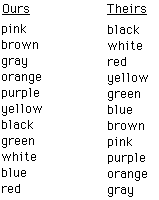Roberto, Jeff, Glenn, Rachel, Meredyth, Don, Roger and myself.
"Imagine a sphere in my hand that has color. Write down all the words that come to mind about its color," said Curtis to our eager group holding an imaginary sphere in his empty hand. Like everyone I dutifully began to write. I wrote: blue, red, yellow,orange, green, gray, white, black, brown, magenta . . .
"OK. Now rank your words according to salience."
What a nice technical word is that one. Like a cold sizzle. "It means a scale of basicness; 'not basic' is one, 'most basic' is ten." The more basic the higher the rank. Curtis explained that its rank is a word's semantic dimension.
He had studied linguistics at the University of Chicago. Curtis had participated in a research project exploring color terms: words in various languages used to describe color. Linguists investigate the history of words in a language. Some color terms occur early in a language's history, others enter the language later. Among linguists salience is a matter of age. The oldest color terms are the most "basic".
One might expect that each linguistic enclave would exhibit an idiosyncratic salience word ordering. Remarkably, Curtis tells us, that the ranking is universal. All languages show the same ranking. It's this one:
Black, white, red, yellow, green, blue, brown, pink, purple, orange, gray.
The list procedes from older through those acquired later to the new.
In most languages the word for red predates that for green. Black predates any color.
This is not an expected result! Why should all cultures have invented a word for the color red before they invented one for the color green? Leaves were not assigned a color name until fire had one! In all cultures.
How did our rankings compare? We each contributed them to the bowl to be averaged out on the blackboard for all to behold. Posted beside our ranking was the one Curtis brought us from the linguists:

I think we won.